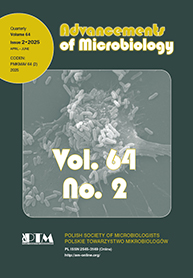Streszczenie: Wirusy ekstremofilne zasiedlają nawet najbardziej nietypowe środowiska, takie jak szyby hydrotermalne zarówno podwodne jak i naziemne, pustynie, tereny subpolarne, osady denne oraz środowiska o wysokim stopniu zasolenia. Są to głównie wirusy, zakażające bakterie (należące do rodzin Myoviridae oraz Siphoviridae) i archeony (zaklasyfikowane do rodzin Lipothrixviridae, Rudiviridae, Yueviridae, Ampullaviridae, Globuloviridae, Sphaerolipoviridae, Bicaudaviridae, Fuselloviridae, Guttaviridae, Clavaviridae oraz Turriviridae), z których część nie została w pełni sklasyfikowana. Ekstremowirusy posiadają materiał genetyczny głównie w postaci dsDNA, zarówno kolistego jak i liniowego, którego średnia długość waha się pomiędzy 14 do 80 kpz i jest optymalna, ponieważ nie ulega rozłożeniu przez wysoka lub niską temperaturę, roztwory soli czy podwyższone ciśnienie i koduje wszystkie cechy niezbędne do funkcjonowania w ekstremalnych warunkach. Potwierdza to także o wiele wyższą oporność DNA na czynniki zewnętrzne w porównaniu z delikatnym RNA. Dalsze badania nad wirusami ekstremofilowymi mogą doprowadzić do pełnego zsekwencjonowania ich genomów, poznania genów warunkujących cechy oporności na niekorzystne warunki środowiskowe oraz przybliżyć poznanie pełnej historii ewolucji organizmów na Ziemi.
1. Wprowadzenie. 2. Wirusy ekstremalnie wysokich temperatur. 2.1. Wirusy z gorących źródeł naziemnych. 2.2. Wirusy z podwodnych szybów hydrotermalnych. 3. Wirusy terenów pustynnych. 4. Wirusy terenów subpolarnych. 5. Wirusy osadów dennych. 6. Wirusy terenów o wysokim stopniu zasolenia. 6.1. Wirusy w jeziorach słodkowodnych. 6.2. Wirusy w jeziorach alkalicznych. 7. Podsumowanie
Abstract: Extremophilic viruses inhabit even the most extreme environments, such as underwater and terrestrial hydrothermal vents, deserts, subpolar areas, deep subsurface sediments, hypersaline environments, and alkaline lakes. These are mainly viruses that infect bacteria (belonging to the Myoviridae and Siphoviridae families) and archaea (classified to the families Lipothrixviridae, Rudiviridae, Yueviridae, Ampullaviridae, Globuloviridae, Sphaerolipoviridae, Bicaudaviridae, Fuselloviridae, Guttaviridae, Clavaviridae, and Turriviridae), some of which have not been fully classified. Extremoviruses have genetic material mainly in the form of dsDNA, both circular and linear, whose average length varies between 14 and 80kbp and is optimal because it is not degraded by high or low temperature, salt solutions or elevated pressure, and encodes all features necessary to function in extreme conditions. This also confirms the much higher resistance of DNA to external factors compared to delicate RNA. Further studies on extremophilic viruses can lead to full sequencing of their genomes, recognition of genes determining resistance traits to unfavorable environmental conditions, and a closer understanding
of the full history of the evolution of organisms on Earth.
1. Introduction. 2. Viruses of extremely high temperatures. 2.1. Viruses of hot terrestrial springs. 2.2. Viruses of deep-sea hydrothermal vents. 3. Viruses of deserts. 4. Viruses of subpolar areas. 5. Viruses of subsurface sediments. 6. Viruses of hypersaline areas. 6.1. Viruses of freshwater lakes. 6.2 Viruses of alkaline lakes. 7. Conclusions

